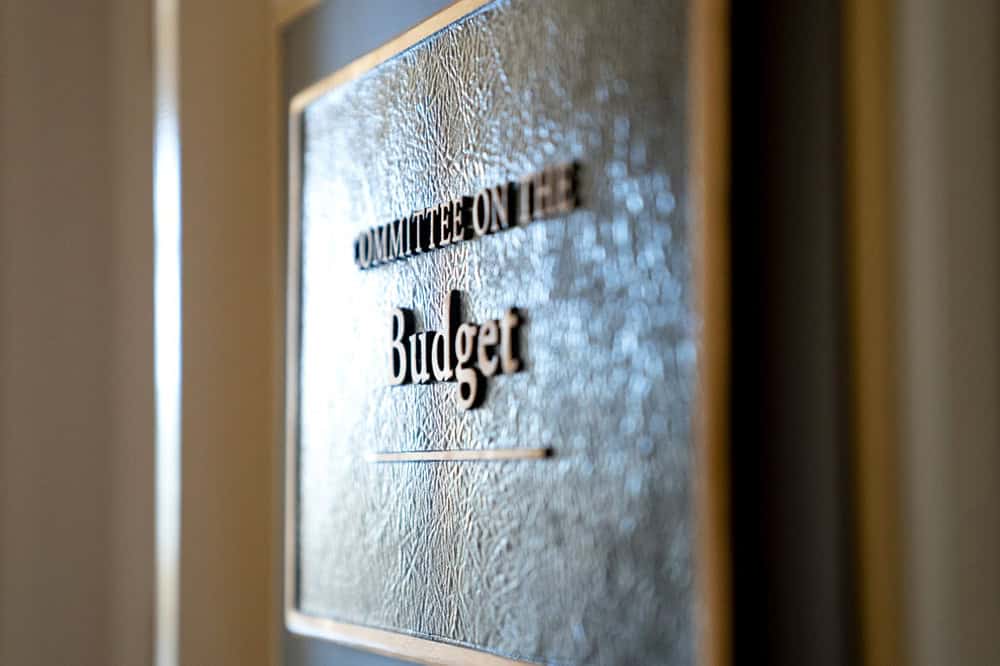As Debt Exceeds $32 Trillion, Strong Bipartisan Majority of Voters Call on Lawmakers to Create Fiscal Commission
Ahead of Today’s New CBO Report, the June 2023 Fiscal Confidence Index is 38 (100 is Neutral)
NEW YORK (June 28, 2023) — As the national debt races past $32 trillion and rises into the future, a strong majority of U.S. voters support a bipartisan fiscal commission to address America’s unsustainable fiscal outlook. More than 6-in-10 voters, including 67% of Democrats, 62% of Independents, and 59% of Republicans, support a fiscal commission process to recommend a comprehensive package of reforms to reduce our national debt, and only 5% of all voters are opposed.
In addition, the U.S. Fiscal Confidence Index, modeled after the Consumer Confidence Index, is at 38, indicating broad concern about our fiscal future. More than 8-in-10 (84%) voters want the president and Congress to spend more time addressing the national debt and 79% of voters agree that the issue should be a top-three priority for the president and Congress.
“Voters understand the urgency of our fiscal challenges, and that’s why they want lawmakers to take concrete steps to secure our future,” said Michael A. Peterson, CEO of the Peterson Foundation. “Leaders of both parties have recently expressed interest in a bipartisan commission process, and a strong majority of voters support that effort. A comprehensive plan to stabilize our debt will have significant benefits for our nation, especially a greater quality of life and economic opportunity for the next generation.”
Further, this afternoon the nonpartisan Congressional Budget Office is scheduled to release new 30-year budget and economic projections, including debt and interest figures, providing updated insights on America’s long-term fiscal challenge.
The Fiscal Confidence Index measures public opinion about the national debt by asking six questions in three key areas:
- CONCERN: Level of concern and views about the direction of the national debt.
- PRIORITY: How high a priority addressing the debt should be for elected leaders.
- EXPECTATIONS: Expectations about whether the debt situation will get better or worse in the next few years.
The survey results from these three areas are weighted equally and averaged to produce the Fiscal Confidence Index value. The Fiscal Confidence Index, like the Consumer Confidence Index, is indexed on a scale of 0 to 200, with a neutral midpoint of 100. A reading above 100 indicates positive sentiment. A reading below 100 indicates negative sentiment.
Fiscal Confidence Index Key Data Points:
- The June 2023 Fiscal Confidence Index value is 38. (The May value was 35. The April value was 37.)
- The current Fiscal Confidence Index score for CONCERN about the debt is 31, indicating deep concern about the debt. The score for debt as a PRIORITY that leaders must address is 21, indicating that Americans want elected leaders to make addressing long-term debt a high priority. The score for EXPECTATIONS about progress on the debt is 63. The Fiscal Confidence Index is the average of these three sub-category scores.
- For a description of the complete methodology, see the Appendix below.
The Peter G. Peterson Foundation commissioned this poll by the Global Strategy Group and North Star Opinion Research to survey public opinion on the national debt. The online poll included 1,000 registered voters nationwide, surveyed between June 20, 2023 and June 21, 2023. The poll has a margin of error of +/- 3.1%. The poll examined voters’ opinions on the national debt, political leadership, and America’s fiscal and economic health.
Detailed poll results can be found online at: www.pgpf.org/FiscalConfidenceIndex.
About the Peter G. Peterson Foundation
The Peter G. Peterson Foundation is a nonprofit, nonpartisan organization that is dedicated to increasing public awareness of the nature and urgency of key fiscal challenges threatening America’s future, and to accelerating action on them. To address these challenges successfully, we work to bring Americans together to find and implement sensible, long-term solutions that transcend age, party lines and ideological divides in order to achieve real results. To learn more, please visit www.pgpf.org.
APPENDIX: Fiscal Confidence Index Methodology and Questions
- The Fiscal Confidence Index is released monthly by the Peter G. Peterson Foundation.
- The Fiscal Confidence Index value is based on six questions in three categories.
- As is done with the Consumer Confidence Index, the first step in calculating the Fiscal Confidence Index is determining the “Relative Value” for each question. This calculation is made by taking the positive response for each question and dividing it by the sum of the positive and negative responses. Each question was asked on a four-point scale, and answers were weighted according to intensity, with the strongest responses counting twice as much as the middle responses (“much” better or worse answers count twice as heavily as “somewhat” better or worse answers).
- The scores for the Concern, Priority, and Expectations categories are determined by averaging the scores derived from the two questions in each category.
- The Fiscal Confidence Index value is converted from the Relative Value to place it on a scale on which 100 indicates equal positive and negative sentiment, while values below 100 indicate negative sentiment and values above 100 indicate positive sentiment.
- The questions are as follows:
| CONCERN (31) | |||
|---|---|---|---|
| Thinking about our national debt over the last few years, would you say your level of concern has increased or decreased? ◊ Is that a lot or just a little? |
June 2023 | May 2023 | Apr 2023 |
| Increased a lot | 47% | 58% | 54% |
| Increased a little | 34% | 29% | 28% |
| Decreased a little | 4% | 3% | 4% |
| Decreased a lot | 2% | 2% | 3% |
| (No change) | 11% | 6% | 9% |
| (Don’t Know/Refused) | 3% | 2% | 2% |
| INCREASED (NET) | 81% | 87% | 82% |
| DECREASED (NET) | 6% | 5% | 6% |
| When it comes to addressing our national debt, would you say things in the United States are heading in the right direction or do you think things are off on the wrong track? ◊ Do you feel that way strongly or just somewhat? |
June 2023 | May 2023 | Apr 2023 |
| Right direction — Strongly | 7% | 6% | 8% |
| Right direction — Somewhat | 23% | 18% | 20% |
| Wrong track — Somewhat | 26% | 26% | 27% |
| Wrong track — Strongly | 38% | 46% | 42% |
| (Neither/Mixed) | 1% | * | 1% |
| (Don’t Know/Refused) | 5% | 2% | 2% |
| RIGHT DIRECTION (NET) | 29% | 24% | 27% |
| WRONG TRACK (NET) | 64% | 73% | 69% |
| PRIORITY (21) | |||
|---|---|---|---|
| Some people say that addressing the national debt should be among the president and Congress’ top 3 priorities. Do you agree or disagree? ◊ Do you feel that way strongly or just somewhat? |
June 2023 | May 2023 | Apr 2023 |
| Strongly agree | 49% | 64% | 57% |
| Somewhat agree | 29% | 20% | 23% |
| Somewhat disagree | 11% | 8% | 12% |
| Strongly disagree | 4% | 3% | 3% |
| (Don’t Know/Refused) | 6% | 5% | 5% |
| AGREE (NET) | 79% | 85% | 80% |
| DISAGREE (NET) | 15% | 11% | 15% |
| And when it comes to our national debt, do you think it is an issue that the president and Congress should spend more time addressing or less time addressing? ◊ Would you say a lot (more or less) time or just a little? |
June 2023 | May 2023 | Apr 2023 |
| A lot more time | 51% | 61% | 54% |
| A little more time | 33% | 26% | 30% |
| A little less time | 5% | 3% | 5% |
| A lot less time | 3% | 5% | 3% |
| (The same amount of time) | 3% | 2% | 4% |
| (Don’t Know/Refused) | 5% | 3% | 3% |
| MORE TIME (NET) | 84% | 88% | 84% |
| LESS TIME (NET) | 8% | 8% | 8% |
| EXPECTATIONS (63) | |||
|---|---|---|---|
| And thinking about our national debt over the next few years, do you expect the problem to get better or worse? ◊ Is that much (better or worse) or just somewhat (better or worse)? |
June 2023 | May 2023 | Apr 2023 |
| Much better | 5% | 6% | 5% |
| Somewhat better | 21% | 20% | 18% |
| Somewhat worse | 35% | 33% | 32% |
| Much worse | 32% | 35% | 37% |
| (No change) | 3% | 3% | 4% |
| (Don’t know/Refused) | 5% | 3% | 3% |
| BETTER (NET) | 26% | 26% | 24% |
| WORSE (NET) | 67% | 68% | 69% |
| And when it comes to our national debt, are you optimistic or pessimistic that the United States will be able to make progress on our national debt over the next few years? ◊ Would you say you are very (optimistic or pessimistic) or just somewhat? |
June 2023 | May 2023 | Apr 2023 |
| Very optimistic | 6% | 8% | 6% |
| Somewhat optimistic | 34% | 34% | 35% |
| Somewhat pessimistic | 38% | 35% | 34% |
| Very pessimistic | 17% | 18% | 20% |
| (Neither/Mixed) | 3% | 3% | 2% |
| (Don’t Know/Refused) | 3% | 3% | 2% |
| OPTIMISTIC (NET) | 40% | 42% | 41% |
| PESSIMISTIC (NET) | 54% | 52% | 54% |
Further Reading
Here’s What a Budget Gimmick Is and How to Spot One
Lawmakers should avoid the use of budget gimmicks, which can hide the true fiscal impact of legislation.
What Is the Farm Bill, and Why Does It Matter for the Federal Budget?
The Farm Bill provides an opportunity for policymakers to comprehensively address agricultural, food, conservation, and other issues.
Social Security Reform: Options to Raise Revenues
Here are the pros and cons for three approaches to increasing funds dedicated to Social Security.


